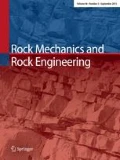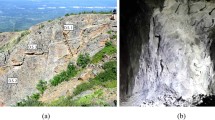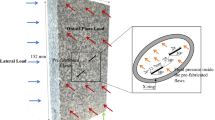Abstract
Experimental uniaxial compression loading tests were conducted on molded gypsum and Carrara marble prismatic specimens to study the cracking and coalescence processes between pre-existing artificial flaws. The study showed that material had an influence on the cracking and coalescence processes (see the companion paper in this issue). As reported in the companion paper, one of the pronounced features as observed in the high-speed video recordings was the development of macroscopic white patches prior to the development of observable cracks in marble, but not in gypsum. This paper (part 2) deals with the microscopic aspects of the study. Specifically, the scanning electron microscope (SEM) and the environmental scanning electron microscope (ESEM) imaging techniques were used to study the microscopic development of white patches and their evolution into macroscopic tensile cracks and shear cracks in marble, and the microscopic initiation of hair-line tensile cracks and their evolution into macroscopic tensile cracks in gypsum. The microscopic imaging study in marble showed that the white patches were associated with extensive microcracking zones (process zones), while the extent of process zone development in gypsum was limited. The comparison of the macroscopic and microscopic results indicates that the different extent of microcracking zone development, related to the material textural properties, is a key factor leading to different macroscopic cracking behavior in gypsum and marble.

























Similar content being viewed by others
Notes
The geometry of a flaw pair is defined by three geometrical parameters as L–β–α, where L is the ligament length (intact rock length between the inner flaw tips), β is the flaw inclination angle (the inclination angle of flaw with the horizontal), and α is the bridging angle (the inclination of a line linking up the inner flaw tips). Please also refer to Fig. 1 of the companion paper for the schematic representation.
Note that, in addition to the coalescence cracks, the sketches contained in Fig. 25 also show the traces of other cracks which also developed from the pre-existing flaws.
References
Alber M, Hauptfleisch U (1999) Generation and visualization of microfractures in Carrara marble for estimating fracture toughness, fracture shear and fracture normal stiffness. Int J Rock Mech Min Sci 36(8):1065–1071
Best MG, Christiansen EH (2001) Igneous petrology. Blackwell Science, Malden, MA
Chen G, Kemeny JM, Harpalani S (1995) Fracture propagation and coalescence in marble plates with pre-cut notches under compression. In: Myer LR, Cook NGW, Goodman RE, Tsang CF (eds) Proceedings of the Symposium on Fractured and Jointed Rock Masses, Lake Tahoe, CA, June 1995, pp 435–439
Kranz RL (1979) Crack growth and development during creep of Barre Granite. Int J Rock Mech Min Sci Geomech Abstr 16:23–35
Li YP, Chen LZ, Wang YH (2005) Experimental research on pre-cracked marble under compression. Int J Solids Struct 42:2505–2516
Martinez AR (1999) Fracture coalescence in natural rock. MSc thesis, Massachusetts Institute of Technology, Cambridge, MA, 341 p
Sagong M, Bobet A (2003) Micro-fractographic characterization of tensile and shear cracks. In: Culligan PJ, Einstein HH, Whittle AJ (eds) Proceedings of the Soil and Rock America Symposium, Cambridge, Massachusetts, June 2003, pp 937–944
Sprunt ES, Brace WF (1974) Direct observation of microcavities in crystalline rocks. Int J Rock Mech Min Sci Geomech Abstr 11:139–150
Tapponnier P, Brace WF (1976) Development of stress-induced microcracks in Westerly granite. Int J Rock Mech Min Sci Geomech Abstr 13:103–112
Wong NY (2008) Crack coalescence in molded gypsum and Carrara marble. PhD thesis, Massachusetts Institute of Technology, Cambridge, MA, 876 p
Wong LNY, Einstein HH Systematic evaluation of cracking behavior in specimens containing single flaws under uniaxial compression. Int J Rock Mech Min Sci (accepted)
Wong LNY, Einstein HH Crack coalescence in molded gypsum and Carrara marble: part 1—macroscopic observations and interpretation. Rock Mech Rock Eng (this issue)
Author information
Authors and Affiliations
Corresponding author
Rights and permissions
About this article
Cite this article
Wong, L.N.Y., Einstein, H.H. Crack Coalescence in Molded Gypsum and Carrara Marble: Part 2—Microscopic Observations and Interpretation. Rock Mech Rock Eng 42, 513–545 (2009). https://doi.org/10.1007/s00603-008-0003-3
Received:
Accepted:
Published:
Issue Date:
DOI: https://doi.org/10.1007/s00603-008-0003-3




